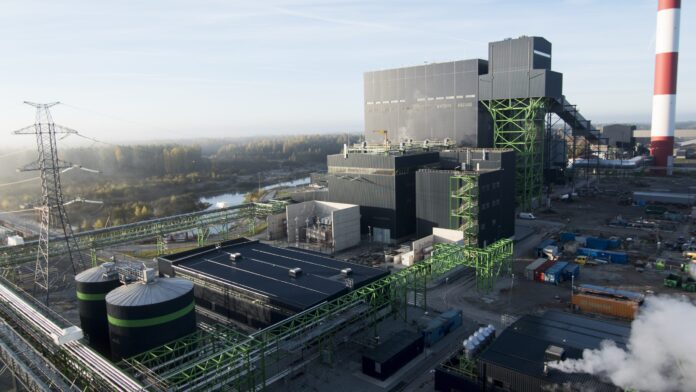Article by Ain Alvela, Editor of TööstusEST.
To meet the climate goals set by the European Union, Estonia’s Ministry of Climate has begun drafting legislation to support the green transition. The bill, now named the Climate-Resilient Economy Act, has already undergone initial review rounds and received over 920 amendment proposals from various organizations.
Since August, the draft bill has been under review by relevant authorities, with a total of 61 organizations submitting amendment proposals. These include both general suggestions and specific recommendations based on individual industrial sectors.
The industrial sector has a series of criticisms regarding the draft bill
The draft bill reflects the Ministry of Climate’s aim to contribute to mitigating climate change, adapting to its impacts, and fostering a more climate-resilient society. At the same time, it seeks to enhance the climate resilience of the economy and establish conditions for the growth of a clean, greenhouse gas-free economy.
While few fundamentally oppose the EU’s climate goals or the overarching aim of the Climate-Resilient Economy Act to meet these targets, industrial agents are mainly concerned that the draft is overly declarative, setting different objectives and requirements while failing to offer solutions for meeting them. For instance, the draft references the need to adopt new “clean” technologies but does not address the availability of such technologies or whether companies in Estonia even have the capacity to implement them in production.
Additionally, lawmakers are criticized for focusing too heavily on setting deadlines for reducing greenhouse gas (CO₂ equivalent) emissions, while the draft has little to do with actual climate-resilient management. Industrial representatives argue that the draft lacks mechanisms to ensure economic growth within the conditions of a green transition. For example, achieving climate neutrality may depend on carbon capture and storage, yet no technologies are available at an industrial scale for this purpose, nor is there clarity on when they might be. Meanwhile, targets are set as though these technologies already exist and are readily available to everyone.
It remains unclear where the funding will come from to meet these targets
The industrial sector is unsettled by the uncertainty surrounding the public and private sectors’ ability to implement such sweeping changes at this scale and pace, especially given the substantial investments required. They believe the calculations and impact analyses in the draft are inadequate. According to the draft, the government must invest €3 billion and the private sector an additional €11.4 billion by 2040 to meet the targets. However, businesses lack investment security. Lawmakers are asked to clarify the basis for assuming that the private sector is prepared to invest €11.4 billion in Estonia, given the current complex geopolitical situation, uncertain economic climate, and rising tax burden, which do not inspire confidence among investors.
The private sector, represented by several industrial companies, argues that the state should not impose greater obligations on businesses and the population than what the country’s current economic situation and companies’ competitiveness can support. They also contend that in implementing the green reform, the focus should not be on limiting the use of local mineral resources, including oil shale, but rather on maximizing the value of local resources.
One prevailing sentiment regarding the draft is that Estonia should not attempt to outpace the EU in achieving climate goals; instead, the country’s actions should align with the general pace set by the union. In other words, the industrial sector believes that Estonia’s targets cannot and should not be stricter than those established at the EU level.
The public sector must encourage and create the necessary conditions
The Ministry of Climate asserts that the law is fair to all, and its implementation is realistic. During a presentation on the climate law draft at the Hydrogen Day event held in Tartu on October 18, Merilyn Möls, an advisor on renewable energy and green technologies at the Ministry of Climate, emphasized that the new law aims to establish a regulatory environment for businesses, leveraging mechanisms of market economy, with a focus on changing the behaviour of the public sector.
“Firstly, it is about setting an example, and secondly, the public sector can stimulate market demand for a cleaner economy,” Möls explains. “Specifically, the goal is for the public sector to phase out the use of fossil fuels by 2040, including the use of fossil fuels for ensuring the reliability of electricity supply. Administrative vehicles, meanwhile, will run on CO₂-free fuels starting from 2035. In addition, we will increase the share of environmentally friendly public procurement, planning, and development programs, directing state investments and support measures towards infrastructure that promotes the green transition and the development of low-emission technologies.”
This should foster the principle that all state decisions move towards sustainable development. As a result, Estonia aims to achieve climate neutrality by 2050.
A key goal is to achieve clean energy
Kristi Klaas, Deputy Secretary General for the Green Transition at the Ministry of Climate, expresses satisfaction with the numerous proposals received. She notes that they were largely constructive and showed that interest groups have engaged deeply and thoughtfully about how the law will impact various sectors. According to Klaas, the ministry is currently processing these proposals, specifically highlighting those that require political decisions and others aimed at making the law clearer. “The opinions of environmental protection organizations and business associations differ significantly regarding the draft. I wouldn’t say there is a fundamental opposition between them, but the differences in assessments are noticeable,” Klaas remarks. “We drafted this bill with a broad vision in mind, primarily focusing on ensuring a prosperous future for Estonia that would benefit everyone.”
According to Klaas, the environmental footprint left by industry is primarily influenced by electricity consumption, followed by transportation and logistics, and then resource utilization, including raw materials. “Electricity must become clean; we need to work towards eliminating fossil fuel-based sources for electricity production. In transportation, the transition to so-called clean fuels largely depends on how many vehicles using alternative fuel sources we can deploy. Additionally, Estonia needs to develop the capacity to produce CO₂-free fuels,” Klaas explains. “In resource utilization, the focus should be on a circular economy – using less primary and more secondary raw materials. The circular economy presents the biggest challenges, as it currently does not function as ideally as it should.”
The funds from emissions trading will be directed towards the green transition
When it comes to reducing industrial emissions, the greatest responsibility lies with oil shale production, which accounts for two-thirds of industrial emissions, while the remaining one-third comes from other industries. According to Klaas, the solutions for each case are different, and the draft approaches them in distinct ways. “The law does not stipulate solutions and technologies that do not yet exist. In reducing industrial emissions, the draft law envisions a phased replacement of fossil fuels with zero-emission input fuels. We are primarily talking about biomethane and hydrogen,” explains Kristi Klaas. “While emissions from oil shale electricity production have significantly decreased in Estonia over the past few decades, the trend in other sectors is the opposite.” She adds that the draft law keeps the door open for the utilization of oil shale, for instance, as a raw material in the chemical industry and in plastics manufacturing. However, the burning of oil shale for energy production or as ship fuel must come to an end. Klaas confirms that in the coming years, 100% of the revenue from emissions trading will be directed towards achieving the objectives set forth in the Climate-Resilient Economy Act.

Photo: Estonian Environmental Board
„Electricity must become clean; we need to work towards eliminating fossil fuel-based sources for electricity production,“ Kristi Klaas.
11,4 billion is the amount companies are expected to invest by 2040 to meet climate goals, but the industrial sector does not understand the basis for this expectation.
WHAT IS WHAT: The draft Climate-Resilient Economy Act
Key directions that the Climate Ministry promises to implement in the proposed Climate-Resilient Economy Act.
- Making space for new industries – the volume of industrial emissions is allowed to increase up to twice its current level by 2030.
- The public sector will cease the use of fossil fuels by 2040, except in areas where there are no technological alternatives.
- Electricity production, including supply security, will be free of CO₂ emissions starting from 2040.
- Heat production will be free of CO₂ emissions starting from 2040.
- New mining permits for oil shale extraction will only be granted for the production of oil shale chemicals or other products that cannot be used as fuels or energy carriers.
- Public transport in major cities will transition to zero emissions by 2040, while taxis in these cities will achieve this by 2035.
- The public sector’s administrative vehicle fleet will be zero-emission by 2035.
- Permits for the implementation of new technologies will be issued through a simplified process.
- 30% of the funds generated from the sale of CO₂ allowances will be directed towards investments by the private sector in new technologies and energy efficiency.
- 25% of public procurements will include CO₂ emissions as one of the evaluation criteria by 2030.
- Eight technology development roadmaps for the implementation of CO₂-free technologies will be created in collaboration with companies.
- A uniform cutting volume will be established, ensuring that logging does not exceed the net growth of economic forests, meaning that the standing stock of economic forests will not decline as a result of logging activities.
- The opportunity for the establishment of separate forest plantations to ensure better resource availability for wood-based durable products and wood chemistry will be created.
- The principles for issuing mining permits for peat production will be changed to achieve a 12% reduction in CO₂ emissions from peat production by 2030 and a 100% reduction in emissions originating from wetlands by 2050.
- A condition for issuing peat mining permits will be the increased valorisation of peat in Estonia starting from 2035.
Source: Ministry of Climate

